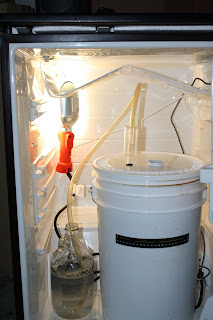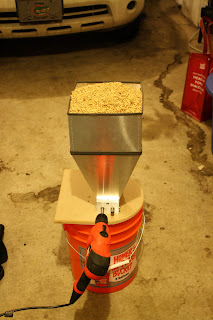
Several beers in primary and secondary at this point, so I thought I would provide an update on some of the stuff that is going on as well as some plans for the near future.
Imperial Stout: We racked the beer to secondary and are still planning on adding raspberries to the secondary for about 3-5 weeks. Oregon Fruit Puree makes fruits, usually used in pies/desserts, that many homebrewers use for their beers. We were having trouble finding the fruit at the grocery stores that we normally go to, but today I was finally able to score 3 cans from a nearby store. We might bottle a couple of bombers before we add the raspberries so we can do a taste comparison with- and without raspberries. Fermentation was good and we finished at 10% alcohol. The hydrometer sample tasted very good and looked very dark. Should be good.
Brown Ale: The last batch of brown ale finished at 1015 which is a little higher than the previous batch of 1011. The higher final gravity is attributable to the higher mash temp and more long-chain sugars which are not fermentable by brewers yeast. Hopefully, the higher gravity will result in a matlier tasting beer. We dry hopped it today and will bottle it in 2 weeks.
Experimental Batch: I havent said much about this beer, as I dont really want Elise to know what is going on before she tries it (swish and spit of course) but we did do a few things we havent done before. First, we used a malt called Carafa. Darker malts are made by kilning them and essentially controlling the "burn" on the husk creating a darker husk (darker the longer it is kilned) and different flavors. Color of malts is measured in degrees Lovibond (L), and for a comparison brown sugar is 50L, chocolate malt is 350L, and Carafa III is 525L. We used a decent amount in the beer, so it is a very dark color. Longer kilning can also lead to a harsher/bitter flavor which is common in a malt called black patent. However, Carafa malts are de-husked, so that the bitter flavor and some of the roasty flavor is removed resulting in mostly color additions with a slight amount of roast. This was also a 2.5 gallon batch (that I boiled on the stove) just in case it doesnt taste very good, I wouldnt be as mad about wasting the money, and time to drink, on a full 5 gallons. We are dryhopping with a full ounce of hops, which by 5 gallon standards would be fairly high. This is more dry hopping than we have done with any beer at this point and we are also going to let the hops sit for ~10 days before we cold crash. At best, the beer will turn into a sort of "black IPA"-type deal with a twist. The twist I wont reveal now, but when I am able to finally taste the bottled version I will share the info.
IPA: while my parents were in town, we were able to brew together so they could see the process. We made an IPA and based the recipe on our previous attempt. The first time we tried to write our IPA recipe it was way to complicated. We were trying to get a beer that had some body along with some malt complexity. To make the beer "complex" we tried using several differnt specialty malts that added up to being a decent portion of the grist. The result? Partly due to underattenuation, but mostly from the amount of malts, was a beer that was way too sweet. The sweetness masked all of the hop bitterness resulting in a very bad example of an IPA. The color was nice looking and if you were to tell people it was a hoppy Red Ale, then it might be good.
For this batch, we only had a total of 5% crystal malts (compared to 8.5% previously) and a little bit of CaraPils for head retention. The beer attenuated very well and ended up at 7.1% alcohol. I think this is just a little too high, but that is an easy fix for next time. The picture above is the gravity sample we took a few minutes ago. It looks darker in the picture than it acutally is, which is a good thing as we though previous attempts were too dark. The sample tasted pretty good with a decent citrus twang from the amarillo, centennial, and cascade hops.
We also "built" the water for this beer instead of using our tap water. The chloride:sulfate ratio helps either accenuate malts (high chloride) or hops (high sulfate) in a beer. Carbonate ions are good pH buffers that are helpful in dark beers as the darker malts are more acidic and can lower the mash pH too low. Carbonates help buffer against this and are therefore commonly seen in local water where dark beers are traditionally made (think Dublin and Guinness). Aurora water is very high in carbonates and has an average chloride:sulfate ratio. To deal with this, we only use 30% of our home water and the other 70% was distilled water which has no ions in it. We then used some brewing salts and stuff from the house (kosher salt and baking soda) to build our water to the specifications we wanted. Hopefully, this combined with the better recipe results in a much better IPA that we can then start to make small tweaks to for our House IPA.
Future
We wont be brewing for a few weeks until my Spring Break. During which we plan to brew our Gatorbait Pale Ale (~5.8% and 60 IBUs) as we have not made that in a long time and are completely out. The following week I have a test on Monday and Thursday, so I am off Tuesday so we are going to try our hand at another strong Belgian ale, the Tripel. Tripels are insidious little beers as they look and taste tame from their golden appearance and drinkability, but they pack a punch at about 9% alcohol. Now that we have a temperature controlled fridge we will be able to keep the beer nice and warm which is needed to get the nice Belgiany yeast characteristics that makes Belgian beers famous. This was the problem with the latest batch of Belgain Pale ale in which I think we feremented it too cold, ~68, as that was the hottest I could get the beer in the house.
Future brews may include a series of beers using a yeast called California Lager, which is used to make the beer Anchor Steam. It is a lager yeast that can be feremented warmer (58-60) instead of normal lager temps (46) but is still very clean. We would make an Anchor-type beer, a schwarzbier, and a Batlic Porter.
We are also tinkering with the idea of doing single hop beers. We would make 2.5 gallons of pale ale hopped to the same IBU rate, but use only 1 kind of hop in each beer. This will help us identify what each type of hop brings in terms of flavor and aroma and should be fun to see how different hops really are.



















































